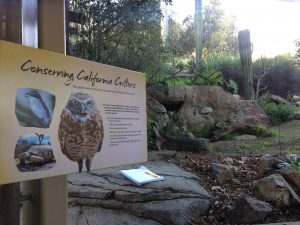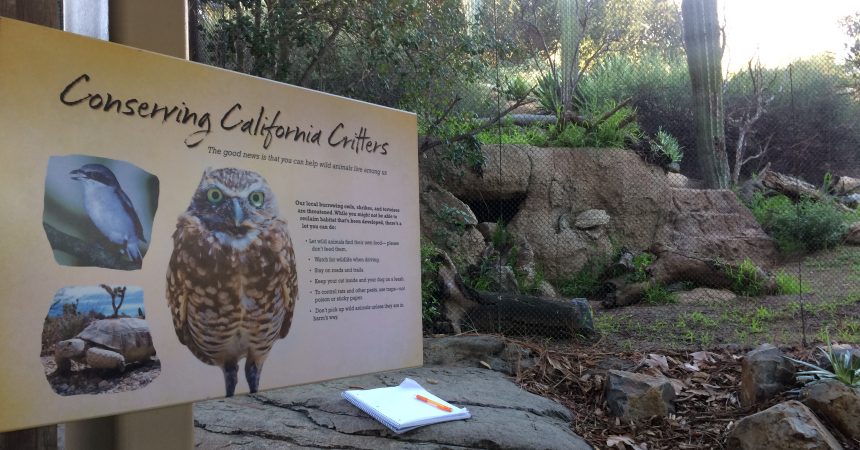Zoo InternQuest is a seven-week career exploration program for San Diego County high school juniors and seniors. Students have the unique opportunity to meet professionals working for the San Diego Zoo, Safari Park, and Institute for Conservation Research, learn about their jobs, and then blog about their experience online. Follow their adventures here on the Zoo’s website!
 If you were to see a western burrowing owl in the wild, you might think it was a stuffed animal. The small bird with speckled feathers and big eyes is admittedly cute, but it is also a fierce predator and a crucial part of San Diego’s ecosystem. As we admired one of these birds up close, Colleen Wisinski, Research Coordinator in Recovery Ecology, showed us some of the ways she and her colleagues at the Institute for Conservation Research are helping protect this species.
If you were to see a western burrowing owl in the wild, you might think it was a stuffed animal. The small bird with speckled feathers and big eyes is admittedly cute, but it is also a fierce predator and a crucial part of San Diego’s ecosystem. As we admired one of these birds up close, Colleen Wisinski, Research Coordinator in Recovery Ecology, showed us some of the ways she and her colleagues at the Institute for Conservation Research are helping protect this species.
Two hundred years ago, San Diego would have consisted of mountains and plains blanketed in native grasses, coastal sage scrub, and cacti. Here, native ground squirrels were present in large numbers. The squirrels were an excellent food source for owls, and they would dig extensive networks of tunnels that western burrowing owls would use to raise their young. However, in present day, housing projects have uprooted native grasses and squirrels have been deemed as “pests” and eradicated from many areas. Burrowing owls have lost their food and shelter, making reproduction and repopulation more difficult for this species of special concern. Ms. Wisinski and her colleagues are working to find the best way to solve these problems individually in order to improve the population holistically.
One of the largest obstacles burrowing owls face is their status. The Department of Fish and Wildlife has named the owl a “Species of Special Concern” which is one level below “Threatened.” Although the burrowing owl could potentially be a threatened species, it is difficult to acquire the title officially because politics, private companies, and funding all play a part in deciding which status is given to specific species. If the burrowing owl were to be declared threatened, more laws at a state and national level would be put in place to protect the owls and their habitats.
Although this title would make her work easier, Ms. Wisinski knows she has no time to spare. For now, she is finding creative solutions to difficult problems. When new housing projects are approved, it is crucial that researchers move any owls away from the path of development. If an owl needs to be relocated, researchers will sometimes put a one-way door in, meaning the owls cannot access their burrow after they leave. A more common method is capturing and temporarily housing the owls in an enclosure for about a month before releasing them. This allows researchers to collect medical data from an owl, place an identification band around its leg, and gives researchers time to find the owl a suitable new home. The final step before releasing an owl back into the wild is giving it a “backpack”- a lightweight GPS system that fits snugly around the owl’s chest. Field biologists must be careful when completing this step because the backpack cannot exceed 5% of the bird’s bodyweight. This is a difficult task for a bird that only weighs about 150 grams!
Once the birds are ready to return to the wild, biologists scout for potential burrows. Because the ground squirrels and other rodents who dig these tunnels are often exterminated, researchers must create their own artificial burrows. Through a series of trial and error, Ms. Wisinski and other researchers have found that a “y” shaped wooden burrow results in the highest rate of successful reproduction for these owls. Relocation can be difficult for burrowing owls because they will commonly try to return to their original burrows. However, Ms. Wisinski and her team have found that playing the sounds of burrowing owls and covering nearby rocks with “whitewash” help the owls become accustomed to their new homes. Biologists may also reintroduce native ground squirrels to provide a source of food and future burrows for the owls. Field biologists continue to monitor burrowing owls after their release in order to track the owls’ health and record their success in breeding.
Although Ms. Wisinski has helped these owls in many ways, she knows they have a long path to stability. The owl faces fire, invasive species, and development on a growing scale. Although the burrowing owl looks small and unassuming, it is an important piece of San Diego’s ecosystem. Ms. Wisinski feels it is her responsibility to help these creatures. As she continues her work, she calls upon others to adopt this same sense of responsibility and help protect this small but powerful native species.
Claire, Conservation Team
Winter Session, 2017


